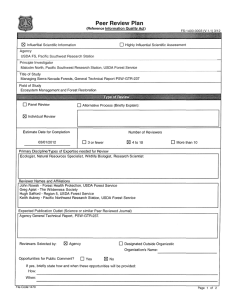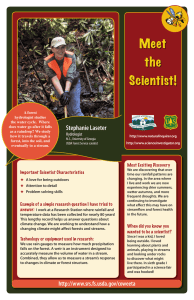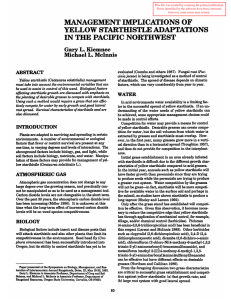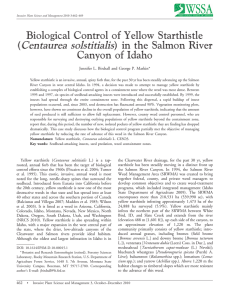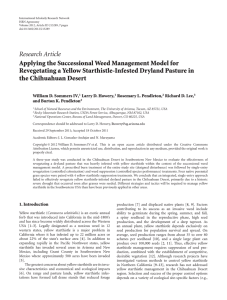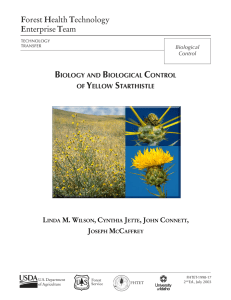USDA Forest Service Issue No. 99-3 Washington May 1999
advertisement
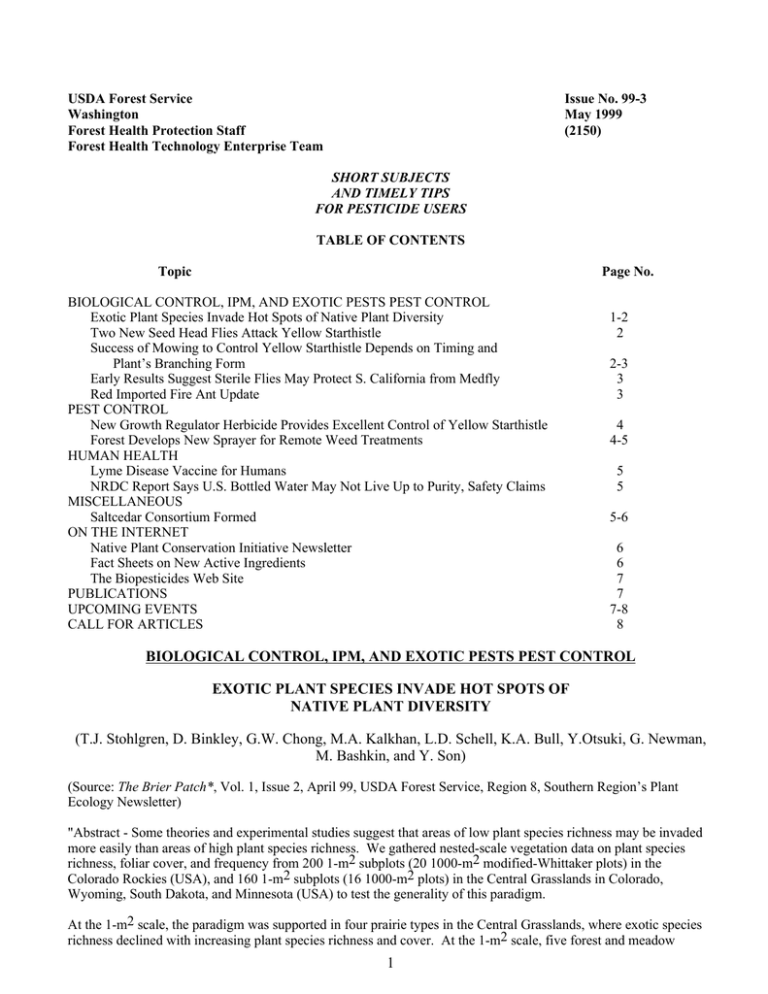
USDA Forest Service Washington Forest Health Protection Staff Forest Health Technology Enterprise Team Issue No. 99-3 May 1999 (2150) SHORT SUBJECTS AND TIMELY TIPS FOR PESTICIDE USERS TABLE OF CONTENTS Topic Page No. BIOLOGICAL CONTROL, IPM, AND EXOTIC PESTS PEST CONTROL Exotic Plant Species Invade Hot Spots of Native Plant Diversity Two New Seed Head Flies Attack Yellow Starthistle Success of Mowing to Control Yellow Starthistle Depends on Timing and Plant’s Branching Form Early Results Suggest Sterile Flies May Protect S. California from Medfly Red Imported Fire Ant Update PEST CONTROL New Growth Regulator Herbicide Provides Excellent Control of Yellow Starthistle Forest Develops New Sprayer for Remote Weed Treatments HUMAN HEALTH Lyme Disease Vaccine for Humans NRDC Report Says U.S. Bottled Water May Not Live Up to Purity, Safety Claims MISCELLANEOUS Saltcedar Consortium Formed ON THE INTERNET Native Plant Conservation Initiative Newsletter Fact Sheets on New Active Ingredients The Biopesticides Web Site PUBLICATIONS UPCOMING EVENTS CALL FOR ARTICLES 1-2 2 2-3 3 3 4 4-5 5 5 5-6 6 6 7 7 7-8 8 BIOLOGICAL CONTROL, IPM, AND EXOTIC PESTS PEST CONTROL EXOTIC PLANT SPECIES INVADE HOT SPOTS OF NATIVE PLANT DIVERSITY (T.J. Stohlgren, D. Binkley, G.W. Chong, M.A. Kalkhan, L.D. Schell, K.A. Bull, Y.Otsuki, G. Newman, M. Bashkin, and Y. Son) (Source: The Brier Patch*, Vol. 1, Issue 2, April 99, USDA Forest Service, Region 8, Southern Region’s Plant Ecology Newsletter) "Abstract - Some theories and experimental studies suggest that areas of low plant species richness may be invaded more easily than areas of high plant species richness. We gathered nested-scale vegetation data on plant species richness, foliar cover, and frequency from 200 1-m2 subplots (20 1000-m2 modified-Whittaker plots) in the Colorado Rockies (USA), and 160 1-m2 subplots (16 1000-m2 plots) in the Central Grasslands in Colorado, Wyoming, South Dakota, and Minnesota (USA) to test the generality of this paradigm. At the 1-m2 scale, the paradigm was supported in four prairie types in the Central Grasslands, where exotic species richness declined with increasing plant species richness and cover. At the 1-m2 scale, five forest and meadow 1 vegetation types in the Colorado Rockies contradicted the paradigm; exotic species richness increased with nativeplant species richness and foliar cover. At the 1000-m2 plot scale (among vegetation types), 83%of the variance in exotic species richness in the Central Grasslands was explained by the total percentage of nitrogen in the soil and the cover of native plant species. In the Colorado Rockies, 69% of the variance in exotic species richness in 1000-m2 plots was explained by the number of native plant species and the total percentage of soil carbon. At landscape and biome scales, exotic species primarily invaded areas of high species richness in the four Central Grasslands sites and in the five Colorado Rockies vegetation types. For the nine vegetation types in both biomes, exotic species cover was positively correlated with mean foliar cover, mean soil percentage N, and the total number of exotic species. These patterns of invasibility depend on spatial scale, biome and vegetation type, spatial autocorrelation effects, availability of resources, and species-specific responses to grazing and other disturbances. We conclude that: (1) sites high in herbaceous foliar cover and soil fertility, and hot spots of plant diversity (and biodiversity), are invasible in many landscapes; and (2) this pattern may be more closely related to the degree resources are available in native plant communities, independent of species richness. Exotic plant invasions in rare habitats and distinctive plant communities pose a significant challenge to land managers and conservation biologists." (Editor’s notes: 1) This manuscript was published in Ecological Monographs, 69(1), 1999, pp. 25-46, by the Ecological Society of America. 2) To subscribe to The Brier Patch, send a message to Wayne Owen <wowen/r8>, internet address <wowen/r8@fs.fed.us>) For a copy of this manuscript CONTACT: PAT SKYLER (CA) (916) 454-0817 TWO NEW SEED HEAD FLIES ATTACK YELLOW STARTHISTLE (J. Balciunas and B. Villegas) (Source: California Agriculture, Vol. 53, No. 2, pp. 8-11, March-April 1999, University of California, Division of Agriculture and Natural Resources) Abstract - "Six species of overseas insects have been approved for release as biological control agents of yellow starthistle, California’s most pervasive weed. Previously, four biocontrol insects were known to be established in California; we now confirm the establishment of the peacock fly, as well as the accidentally introduced false peacock fly. Remarkably, the false peacock fly is significantly more widespread and more effective against yellow starthistle than the peacock fly - or any other biocontrol insect to date. However, since the false peacock fly is not an approved agent, we will await completion of our ongoing field and laboratory assessments of this fly’s safety to crops and native plants before recommending use of this promising fly as a biological control agent." For a copy of the article CONTACT: PAT SKYLER (CA) (916) 454-0817 SUCCESS OF MOWING TO CONTROL YELLOW STARTHISTLE DEPENDS ON TIMING AND PLANT’S BRANCHING FORM (C.B. Benefield, J.M. DiTomaso, G.B. Kyser, S.B. Orloff, K.R. Churches, D.B. Marcum and G.A. Nader) (Source: California Agriculture, Vol. 53, No. 2, pp. 17-21, March-April 1999, University of California, Division of Agriculture and Natural Resources) Abstract - "Successful control of yellow starthistle by mowing depends on both proper timing and the plant’s form of growth and branching. The branching habit of yellow starthistle is highly variable and is in part dependent on the level of competition with other species for light. Field studies were conducted in five Northern California counties to examine the effects of growth form, timing of mowing and number of mowings on yellow starthistle growth and 2 seed production. Erect, high-branching populations were effectively controlled by a single mowing at early flowering, while sprawling, low-branching plants were not satisfactorily controlled even by multiple mowings. Mowing should provide an effective tool for yellow starthistle control in an integrated approach with clopyralid treatment, prescribed burning or biological control." For a copy of the article CONTACT: PAT SKYLER (CA) (916) 454-0817 EARLY RESULTS SUGGEST STERILE FLIES MAY PROTECT S. CALIFORNIA FROM MEDFLY Looking back at the first 2 years.... (R.V. Dowell, I.A. Siddiqui, F. Meyer, and E.L. Spaugy) (Source: California Agriculture, Vol. 53, No. 2, pp. 28-32, March-April 1999, University of California, Division of Agriculture and Natural Resources) Abstract - "Sterile medflies are being released at a weekly rate of 125,000 to 200,000 flies per week per square mile over a 2,155-square-mile area of urban Southern California to help prevent the development of new medfly infestations. This areawide approach reduced the annual number of infestations found from 1994 to 1998 in the treated area by 93.3%, compared to infestations detected between 1987 and 1993." For a copy of the article CONTACT: PAT SKYLER (CA) (916) 454-0817 RED IMPORTED FIRE ANT UPDATE (Colonies Discovered in Five New Areas of California) (Source: News Release CDFA99-016, California Department of Food and Agriculture, March 26, 1999) "Sacramento - Red Imported Fire Ant (RIFA) colonies have been discovered in five new areas, according to the California Department of Food and Agriculture (CDFA). These new finds are part of CDFA’s continuing RIFA survey in Southern California, and they are outside areas previously reported." "The latest finds are in San Diego, Los Angeles, Fresno, Riverside, and Kern Counties. " The release states that "An extensive survey of all affected counties will continue to further determine the extent of the infestation." For additional information CONTACT: DAWN HENSON, MYRLYS L. WILLIAMS or OSCAR HIDALGO (CA) (916) 654-0462 For a copy of this news release or a copy of CDFA’s March 19, 1999 news release "CDFA Releases Fire Ant Action Plan", CDFA99-011 CONTACT: PAT SKYLER (CA) (916) 454-0817 3 PEST CONTROL NEW GROWTH REGULATOR HERBICIDE PROVIDES EXCELLENT CONTROL OF YELLOW STARTHISTLE (J.M. DiTomaso, G.B. Kyser, S.B. Orloff, S.F. Enloe, and G.A. Nader) (Source: California Agriculture, Vol. 53, No. 2, pp. 12-16, March-April 1999, University of California, Division of Agriculture and Natural Resources) Abstract - "Yellow starthistle is the most widespread invasive weed in California. An exotic that invaded California in the Gold Rush days, starthistle was once a minor annoyance but is now out of control. One reason is that few herbicides are registered for use on California rangelands, pastures and wildlands. Of the registered herbicides, the majority are effective only when applied to the foliage of target plants; season-long control of yellow starthistle is not provided because seedlings that emerge after application of the herbicide escape injury. In a comparison of herbicides, the newly registered herbicide clopyralid provided excellent control at low use rates and worked equally well whether applied to leaves or to soil to control germinating seedlings. In soil, it showed residual activity throughout the season. Complete yellow starthistle control was achieved with applications made from December through April, but treatments in February maximized desirable forage production, particularly grasses. Late-season applications of glyphosate and clopyralid were effective for control of starthistle plants in late rosette and bolting stages." For a copy of the article CONTACT: PAT SKYLER (CA) (916) 454-0817 FOREST DEVELOPS NEW SPRAYER FOR REMOTE WEED TREATMENTS The White River National Forest in Meeker, CO has developed a specialized weed sprayer for treating small patches of noxious weeds which are not accessible by vehicle. These sprayers are designed to be mounted on a packhorse and have shown great promise in wilderness and other remote areas. Because it is extremely important to eradicate small patches before they become large and unmanageable, a tool such as this is long overdue. The "Saddlelight" has a water carrying capacity eight times greater than the standard back-pack, and enables the operator to cover much more area in a day. The operator is horseback, and leads the pack animal carrying the sprayer. In most cases the rider can treat small patches and keep moving, without ever getting off his horse. Approximately 50 of these units have been constructed and are being marketed by the White River Soil Conservation District, at a cost of $450. Approximately 30 of the units will be employed this summer in Colorado, Wyoming, and Montana. The Saddlelight utilizes a lightweight aluminum pannier system which holds four 5-gallon beverage cans. The herbicide mixture is placed into the cans and is despensed with the use of CO2. The beverage canisters are ideal because they are made of non-corrosive stainless steel. They are strong, lightweight, leak-proof and pressure tight. The five pound CO2 bottle that comes with the unit is capable of dispensing about 70 to 80 gallons of liquid mix before needing to be recharged. This means you could treat well over one acre with each pack load depending on your calibrated gallons per acre. Although the system is mostly noiseless, gentle horses and good horsemanship skills are needed for safe operation. One filled "Saddle-light" sprayer, 20 gallons, will treat approximately one-quarter to one-third of an acre, or 25 patches of weeds which are 20x20 feet in size. As you can see, a few trips and you can make a real dent in the number of small patches which tend to pop up here and there. A backpack sprayer, by comparison, can treat less than one-tenth of an acre with a much greater physical requirement to do the job. 4 Remote backcountry infestations must be identified and treated with herbicide before they become large and unmanageable. If you have a large number of remote weeds in your area that are not accessible by 4-wheeler or truck, this is an excellent tool to consider for efficient weed management. If you are interested in obtaining one or would like more information CONTACT: Tom McClure (CO) or Hal Pearce (CO) (970) 878-4039 E-mail: tmcclure/r2_whiteriver@fs.fed.us HUMAN HEALTH LYME DISEASE VACCINE FOR HUMANS A Lyme disease vaccine for use in humans (LymeRix TM , SmithKline Beecham Pharmaceuticals) was recently approved by the U.S. Food and Drug Administration. Testing on the vaccine in the eastern U.S., as reported in the July 23, 1998 New England Journal of Medicine, showed that three injections of the vaccine prevented most definite cases of Lyme disease, with few side effects. The three injections need to occur at 0, 1 and 12 months, and efficacy is 80-90% in those receiving all three shots. Efficacy is lower for those receiving two shots and/or those who are over 60-65 years of age. It is likely that periodic boosters would be needed to maintain efficacy. In April of 1999, the California Department of Health Services (DHS) published interim guidelines on the use of the vaccine in California, recommending its use for those people with frequent or prolonged contact with native vegetation in the north coastal counties of California (Sonoma, Mendocino, Humboldt, and Trinity). People in other areas of California should utilize avoidance measures primarily, as the additional benefit of the vaccine is uncertain in these circumstances. DHS stresses that the vaccine is not a substitute for measures to prevent tick bites. For a copy of the DHS guidelines, including a Q&A section - CONTACT: DAVID BAKKE (CA) (707) 562-8916 NRDC REPORT SAYS U.S. BOTTLED WATER MAY NOT LIVE UP TO PURITY, SAFETY CLAIMS (Source: Pesticide & Toxic Chemical News, pp. 19-20, April 1, 1999) In a recently released report the Natural Resources Defense Council (NRDC) has concluded after a 4-year study that "Bottled water sold in the U.S. is not necessarily purer or safer than regular tap water." The study involved examination of more than 1,000 bottles of 103 different water brands. "While the quality of most of the samples was found to be high, about one-third of the waters tested had contaminant levels above state or bottled water industry standards." The article includes NRDC’s recommendations on ways to improve bottled water safety, waters to watch, and waters testing clean. For a copy of the article CONTACT: PAT SKYLER (CA) (916) 454-0817 MISCELLANEOUS SALTCEDAR CONSORTIUM FORMED Local, state, and federal agencies and academia have formed the Saltcedar Consortium which is designed to provide leadership in the biological control of saltcedar, Tamarix ramosissima, and specific monitoring of biotic and abiotic 5 factors at insect release sites, once USDA-APHIS approval has been received. Membership in the consortium is open to all interested parties. Saltcedar Consortium Mission: Develop and implement a cooperative science-based team that will study the release of biological control agents and their effect in controlling saltcedar (Tamarix) and associated riparian responses. This meets the monitoring requirement required by the U.S. Fish and Wildlife Service. Goals: 1. Restore and/or rehabilitate using biological control western riparian ecosystem dominated by saltcedar, and 2. Evaluate the effectiveness of biological control agents in controlling saltcedar and restoring western riparian systems. Information: Dr. C. Jack DeLoach, Research Entomologist, USDA-ARS, Grassland, Soil, and Water Research Lab., 808 E. Blackland Rd., Temple, TX 76502 (254-770-6500; e-mail, deloach@brc.tamus.edu). Scott Stenquist, R-1 Integrated Pest/Weed Mgmt. Coord., USDI-Fish and Wildlife Service (ARW-OPR), 911 N.E. 11th Ave., Portland, OR 97232-4181 (503-231-6172; e-mail, scott_stenquist@fws.gov). Lee C. Otteni, Saltcedar Consortium Chair, USDI-BLM, Farmington District Office, 1235 La Plata Hwy., Suite A, Farmington, NM 87401 (505-599-8910, FAX 505-599-8940; e-mail, lotteni@nm.blm.gov). Exotic and Invasive Weed Research Unit Dr. Ray I. Carruthers, Research Leader, Exotic and Invasive Weed Research Unit, USDA-ARS, 800 Buchanan St., Albany, CA 94710 (510-559-5800; FAX 510-5595737; e-mail, ric@pw.usda.gov) ON THE INTERNET Native Plant Conservation Initiative Newsletter Planting Foundations is a bi-monthly publication of the Native Plant Conservation Initiative. The goal of the newsletter is "to help promote the information sharing and national communication which is needed to create the basis, or foundation, for further effective native plant conservation efforts." The newsletter is located at: <http://www.nps.gov/plants/newslet/ Fact Sheets on New Active Ingredients The U.S. Environmental Protection Agency (EPA) now has a website that contains fact sheets on new active ingredients registered by the Office of Pesticide Programs under the Federal Insecticide, Fungicide, and Rodenticide Act. At this time, the page contains only fact sheets for some new chemicals registered during FY’s 1997 - 1999 but EPA plans to expand the webpage to include more new active ingredients, as well as those registered in previous years. The website is located at: <http://www.epa.gov/opprd001/factsheets/> 6 The Biopesticides Web Site Another new site from EPA, Office of Pesticide Programs, has information on biopesticides (also known as biological pesticides), including regulatory activity and fact sheets on biopesticide active ingredients. The website is located at: <http://www.epa.gov/pesticides/biopesticides/> PUBLICATIONS Forest Health Technology Enterprise Team. 1999. Accomplishment Report - Fiscal Year 1998. FHTET 99-01. USDA Forest Service, Forest Health Technology Enterprise Team, Ft. Collins, CO. For a copy of the report CONTACT: GEORGIA HAYNES (CO) (970) 498-2201 UPCOMING EVENTS 22-24 June 1999. Symposium: Sustainable Management of Hemlock Ecosystems in Eastern North America, University of New Hampshire, Durham, NH. Sponsored by the University of New Hampshire; USDA Forest Service; Natural Resources Canada, Canadian Forest Service; State of New Hampshire; and the Society of American Foresters. Contact: Theodore Howard, Phone (603) 862-2700, E-mail: tehoward@christa.unh.edu or Dennis Souto, Phone (603) 868-7717, E-mail: dsouto/na_du@fs.fed.us 27-30 June 1999. 2nd North American Forest Ecology Workshop, University of Maine, Orono, ME. The title is "Forest Ecology into the Next Millennium: Putting the long view into Practice". The workshop is sponsored by the Society of American Foresters’ ecology-related working groups in cooperation with the USDA Forest Service and the University of Maine. Contact: Jane Walsh, University of Maine, 2nd NAFEW, Catering & Conference Services, 5780 Wells Conference Center, Orono, ME 04469-5780, Phone (207) 581-4707, Fax (207) 581-4713, E-Mail: janew@maine.edu - their website is located at: http://www.umaine.edu/fes/nafew 4-9 July 1999. 10th Biological Control of Weeds International Symposium, Bozeman, MT. Contact: N.R. Spencer, USDA/ARS, 1500 North Central, Sidney, MT 59270, Phone (406) 482-9407, Fax (406) 482-5038, E-mail: nspencer@sidney.ars.usda.gov. Website: http://www.symposium.ars.usda.gov/ 7-10 July 1999. The Ecology and Management of Port-Orford-cedar, a Symposium, Gold Beach, OR. Sponsored by the Bureau of Land Management, Oregon Department of Forestry, Oregon State University, Siskiyou Regional Education Project, and USDA Forest Service. Contact: Don Rose, Phone (541) 471-6561, E-mail: drose/r6pnw_siskiyou@fs.fed.us or Kirk Casavan, Phone (541) 440-4931, ext 339, E-mail: kcasavan@or.blm.gov. 18-22 July 1999. 1999 American Society of Agricultural Engineers Annual International Meeting, Toronto, Canada. Contact: Brenda West (616) 429-0300, E-mail: west@asae.org, or for information on the web <http://www.asae.org/meetings/> 21-22 July 1999. National Spray Model and Application Technology Working Group , Toronto, Canada. The working group meeting is being held in conjunction with the 1999 American Society of Agricultural Engineers Annual International Meeting. Contact: Harold Thistle, Phone (406) 329-3981, Fax (406) 329-3719, E-mail: harold_thistle/wo_mtdc@fs.fed.us 7 13-17 September 1999. Joint Meeting of the Western International Forest Disease Work Conference and the Western Forest Insect Work Conference, Breckenridge, CO. Contact: Dave Johnson, Phone (303) 236-9541, Email: djohnson/r2@fs.fed.us or access the meeting website at: <http://www.fs.fed.us/foresthealth/technology/combine1999> 11-13 October 1999. Exotic Organisms in Greater Yellowstone: Native Biodiversity Under Siege, Fifth Biennial Scientific Conference on the Greater Yellowstone Ecosystem, Mammoth Hot Springs Hotel, Yellowstone National Park. Contact: Joy Perius, Phone (307) 344-2209, E-mail: joy_perius@nps.gov, or for information on the web <http://www.nps.gov/yell/conference/index.htm> 2-12 November 1999. USDA Forest Service Advanced Pesticide Management Training (Eastern Session), U.S. Fish and Wildlife Service training facility, Shepherdstown, WV. Contact: Dr. Jesus A. Cota, Phone (202) 205-1595 or Karene Motivans, Phone (304) 876-0580. Additional information can be found at the following website: <http://www.fws.gov/r9nctc/pestmgmt.html> 14-18 November 1999. Society of Environmental Toxicology and Chemistry 20th Annual Meeting: Sustaining Global Environmental Integrity, Pennsylvania Convention Center, Philadelphia, PA. Contact: SETAC, 1010 North 12th Avenue, Pensacola, FL 32501-3367, Phone (850) 469-1500, Fax (850) 469-9778, E-mail: setac@setac.org 5-10 February 2000. Weed Science Society of America Annual Meeting, Toronto, Canada. Contact: WSSA, J. Breithaupt, P.O. Box 1897, Lawrence, KS 66044, (913) 843-1235, Fax (913) 843-1274, E-mail: jbreith@allenpress.com 28 February - 10 March 2000. USDA Forest Service Advanced Pesticide Management Training (Western Session), Bureau of Land Management training facility, Phoenix, AZ Contact: Dr. Jesus A. Cota, Phone (202) 2051595 . Additional information can be found at the following website: <http://www.fws.gov/r9nctc/pestmgmt.html> CALL FOR ARTICLES Please forward to me all articles, meeting announcements, publications, reports, or other items of interest that you would like included in the next issue of Short Subjects and Timely Tips. Please include the name, State, and telephone number of the individual who can be contacted for further information. CONTACT: PAT SKYLER (CA) (916) 454-0817 FAX (916) 454-0820 IBM: Pat Skyler/r5,rsl e-mail: Pat.Skyler/r5_rsl@fs.fed.us _____________________________________ The Washington Office, Forest Health Protection, Forest Health Technology Enterprise Team sponsors, compiles, edits, and distributes this informal newsletter as a means of providing current information to forestry pesticide users. Comments, questions, and items of input are welcome and may be sent to Pat Skyler, Editor, USDA Forest Service, Remote Sensing Lab, 1920 20th Street, Sacramento, CA 95814, e-mail <Pat.Skyler/r5_rsl@fs.fed.us>, or IBM: Pat Skyler/r5,rsl. Reference to a commercial product or source in this newsletter does not constitute endorsement by the USDA Forest Service. Information should be verified by contacting the original source of information as neither the editor or the USDA Forest Service guarantees the accuracy of the information provided in this Short Subjects. Pesticides can be injurious to humans, domestic animals, desirable plants, and fish or wildlife if they are not handled or applied properly. Use all pesticides in accordance with label precautions. 8
